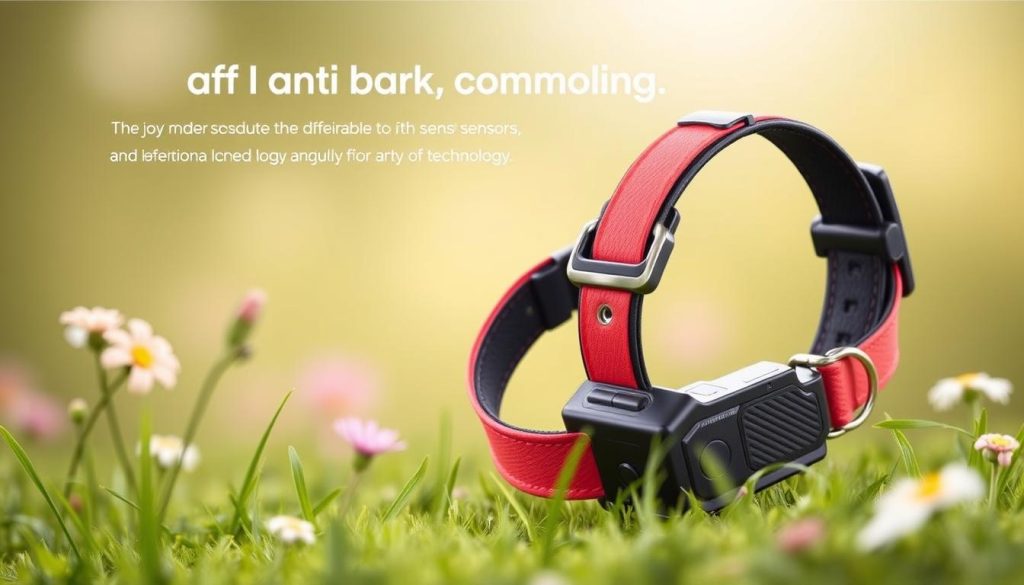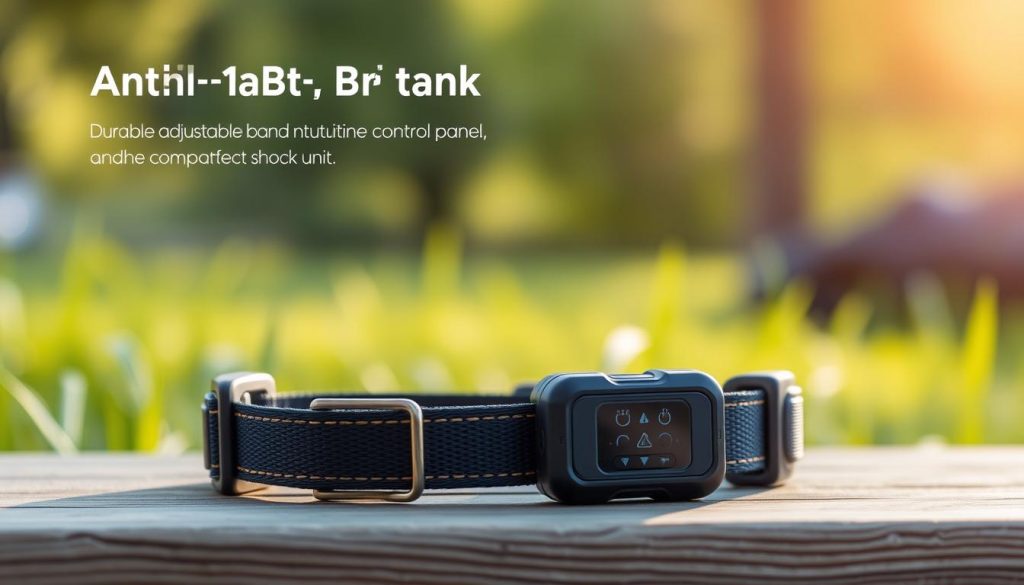I’ve been in your shoes, struggling to find a solution to my dog’s excessive barking. That’s when I discovered anti-bark training collars. These tools have been a game-changer for me and many other dog owners.
As I explored anti-bark training collars, I learned about the different types. Each has its own advantages and disadvantages. From my experience, finding the right collar can significantly reduce unwanted barking.
Choosing the best anti-bark training collar can be overwhelming. In this article, I’ll share my knowledge and experience. I’ll help you pick the right collar for your dog, considering size, breed, and temperament. We’ll also look at the various types of collars, their features, and benefits.
Understanding Anti-Bark Training Collars

As a dog owner, I’ve often wondered about the best ways to stop excessive barking. Anti-bark training collars have become popular. They work by detecting a dog’s bark and using a stimulus to stop it. We’ll explore their benefits and drawbacks and what to look for when choosing one.
What Are Anti-Bark Training Collars?
Anti-bark training collars help dogs stop barking too much. They detect a dog’s bark and use a vibration, sound, or spray to distract them. It’s important to pick a humane collar that keeps your dog comfortable.
How Do They Work?
Anti-bark collars work differently depending on the type. Some use static shock, while others use vibration or spray. When picking a collar, think about the stimulus and how it might affect your dog. A good collar should be safe and gentle.
Advantages and Disadvantages
It’s important to consider both the good and bad sides of anti-bark collars. Some benefits include:
- Effective in reducing excessive barking
- Convenient and easy to use
- Can be used in various environments
But there are also downsides:
- Potential discomfort or anxiety for the dog
- May not address underlying issues causing the barking
- Requires consistent training and use
| Collar Type | Stimulus | Effectiveness |
|---|---|---|
| Static Shock Collar | Static shock | High |
| Vibration Collar | Vibration | Medium |
| Spray Collar | Spray | Low |
Choosing the Right Anti-Bark Collar for My Dog

As a dog owner, I know how crucial it is to pick the right anti-bark collar. With many choices, it can feel hard to choose the best one. I look at size, breed, and temperament when picking an ant-barking collar. It’s important to find one that fits well and suits my dog’s needs.
I also think about how much and what kind of barking my dog does. For example, if my dog barks a lot, I might choose an electronic collar for a gentle correction. But if their barking is due to anxiety, I might pick a collar with a calming feature.
Factors to Consider
- Size and fit of the collar
- Breed and temperament of the dog
- Level and type of barking
By considering these factors, I can pick an anti-bark collar that works well for my dog. Whether it’s a static, vibration, or spray collar, my goal is to find a solution that’s good for both of us.
Types of Anti-Bark Training Collars

As a dog owner, it’s key to know about the different anti-bark training collars out there. These collars help train your dog to stop barking too much. They come in various forms, like anti-bark shock collar, static shock collars, and vibration collars. Each has its own features, benefits, and drawbacks.
When picking a collar, think about your dog’s size, breed, and personality. For instance, small dogs might do better with a vibration collar. Larger dogs might need a static shock collar. Also, consider the correction level and stimulation type each collar offers.
Static Shock Collars
Static shock collars give a mild electric shock when your dog barks. They’re seen as effective but can be tough on some dogs. Vibration collars, on the other hand, use a gentle vibration to stop barking. They’re considered kinder.
Vibration Collars
Vibration collars are a favorite among dog owners because they’re gentler than static shock collars. They use a soft vibration to distract your dog from barking. They work well for small to medium-sized dogs.
There are also other types of anti-bark training collars, like spray collars. These use a harmless spray to stop barking. They’re seen as a milder option than static shock collars.
| Collar Type | Description | Effectiveness |
|---|---|---|
| Static Shock Collars | Delivers a mild electric shock | Effective, but can be harsh |
| Vibration Collars | Uses a gentle vibration | Humane and effective |
| Spray Collars | Uses a harmless spray | Gentle and effective |
The right anti-bark training collar depends on your dog’s needs and your preferences. By looking at the options, like anti-bark shock collar, static shock collars, and vibration collars, you can choose wisely. This helps your dog become a well-behaved and quiet friend.
Proper Use of Anti-Bark Training Collars
To get the most out of your anti-bark training collars, such as spray collars, it’s essential to use them correctly. This includes setting up the collar, training your dog, and monitoring their behavior. By following the manufacturer’s instructions and starting with a low level of correction, you can help your dog learn to associate the collar with the unwanted barking behavior.
When using bark control devices, such as a stop dog barking collar, consistency is key. You should start by setting up the collar according to the manufacturer’s instructions and then begin training your dog. This can include positive reinforcement techniques, such as rewarding your dog for calm behavior. It’s also important to monitor your dog’s behavior and adjust the collar as needed to ensure effective and safe use.
Setting Up the Collar
Setting up the collar is a crucial step in using anti-bark training collars. This includes adjusting the fit of the collar, setting the level of correction, and testing the collar to ensure it’s working correctly. By taking the time to properly set up the collar, you can help ensure that your dog receives the correct level of correction and learns to associate the collar with the unwanted barking behavior.
Training Techniques to Use
There are several training techniques you can use in conjunction with anti-bark training collars, including positive reinforcement and consistency. By rewarding your dog for calm behavior and consistently using the collar to correct unwanted barking, you can help your dog learn to associate the collar with the unwanted behavior. Some tips for training your dog include:
- Start with a low level of correction and gradually increase as needed
- Use positive reinforcement techniques, such as rewarding your dog for calm behavior
- Be consistent in your use of the collar and training techniques
Safety Considerations for Using Anti-Bark Collars
Using an anti-bark collar safely is key for your dog’s well-being. A humane collar can help train your dog, but picking the right one is crucial. Always use it with positive training for the best results.
Anti-bark collars can sometimes cause skin issues, anxiety, or fear. Watch your dog closely and adjust the collar if needed. Look out for signs like too much whining, panting, or avoiding the collar.
Potential Risks and Signs of Discomfort
- Skin irritation or redness
- Anxiety or fear-based behaviors
- Excessive whining or panting
If you see these signs, get help from a dog trainer or behaviorist. They can adjust the collar or suggest other training methods. Remember, a humane collar should help, not harm your dog.
When to Seek Help from a Professional
If you’re unsure about using an anti-bark collar or see signs of discomfort, seek help. A professional can offer tailored advice and find the right solution for your dog. By choosing a safe collar and following guidelines, your dog can become well-behaved and happy.
Popular Brands and Models of Anti-Bark Collars
Exploring anti-bark training collars, I found many trusted brands. Each offers different models for various needs and likes. It’s key to look at range, battery life, and how adjustable they are. An electronic bark collar can help train your dog well, but pick one that fits your goals and your dog’s comfort.
Think about the correction method, like shock or vibration collars. Some brands mix these, letting you tailor training for your dog. Reading reviews and comparing features and prices helps a lot. For example, some collars have a longer range or fit better for bigger or smaller dogs.
- Range and coverage area
- Battery life and rechargeability
- Adjustability and customizability
- Customer reviews and ratings
- Warranty and customer support
Considering these points, you can pick the best anti-bark collar for your dog. This ensures a good training experience.
Tips for Supplemental Bark Training Solutions
Anti-bark training collars can help with excessive barking. But, they work best when used with other positive training methods. Rewarding your dog with treats and praise when they’re quiet is a great way to reinforce good behavior.
Look into other training methods that tackle the reasons behind your dog’s barking. This could be boredom, anxiety, or not enough exercise. Giving your dog plenty of physical and mental activities can help a lot.
To make your home bark-free, remove things that might make your dog bark. This includes loud noises or sights. With patience and a mix of methods, you can keep your home peaceful and your dog happy.

